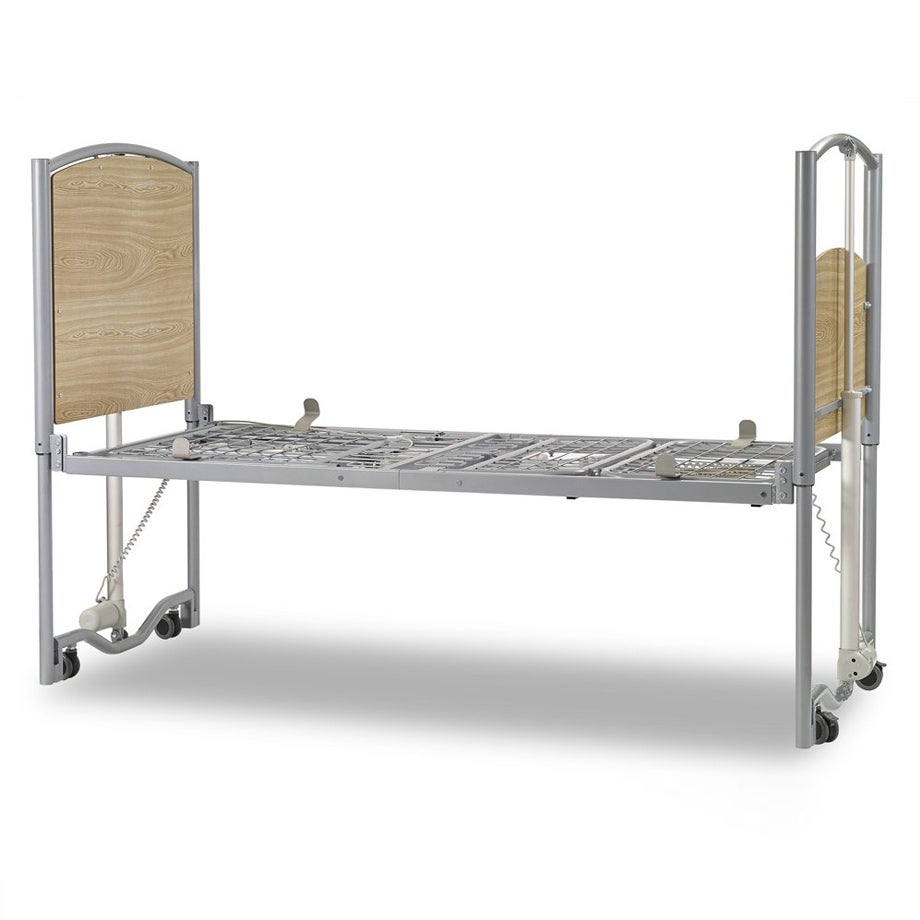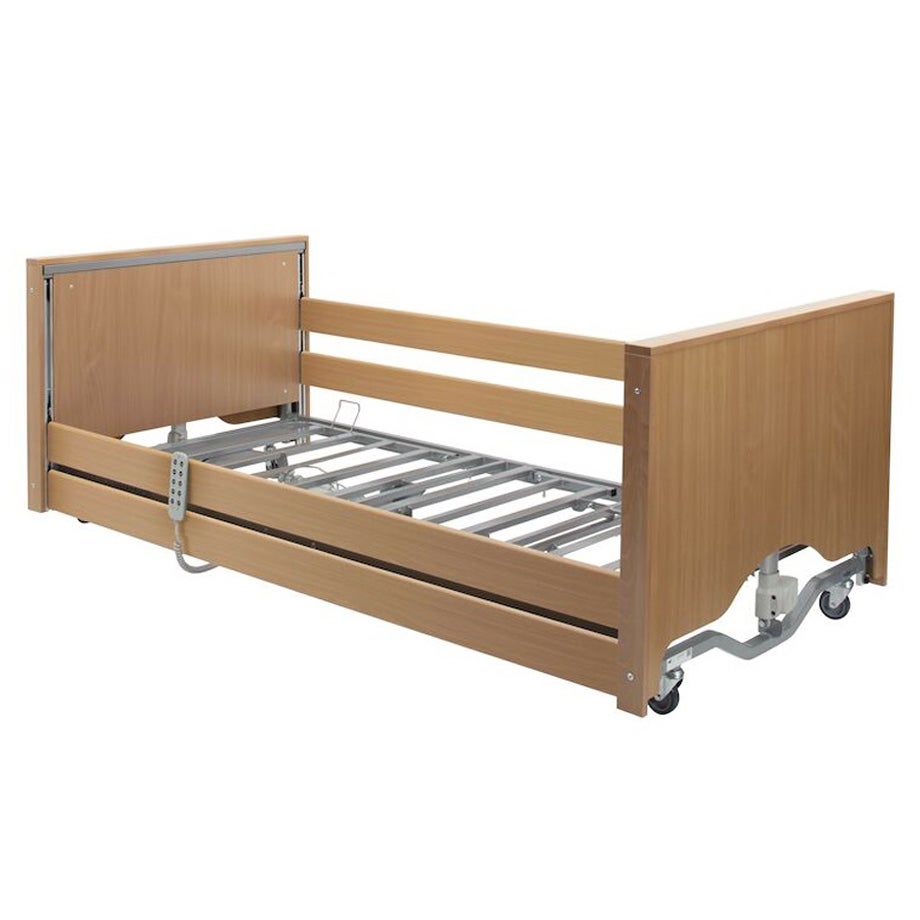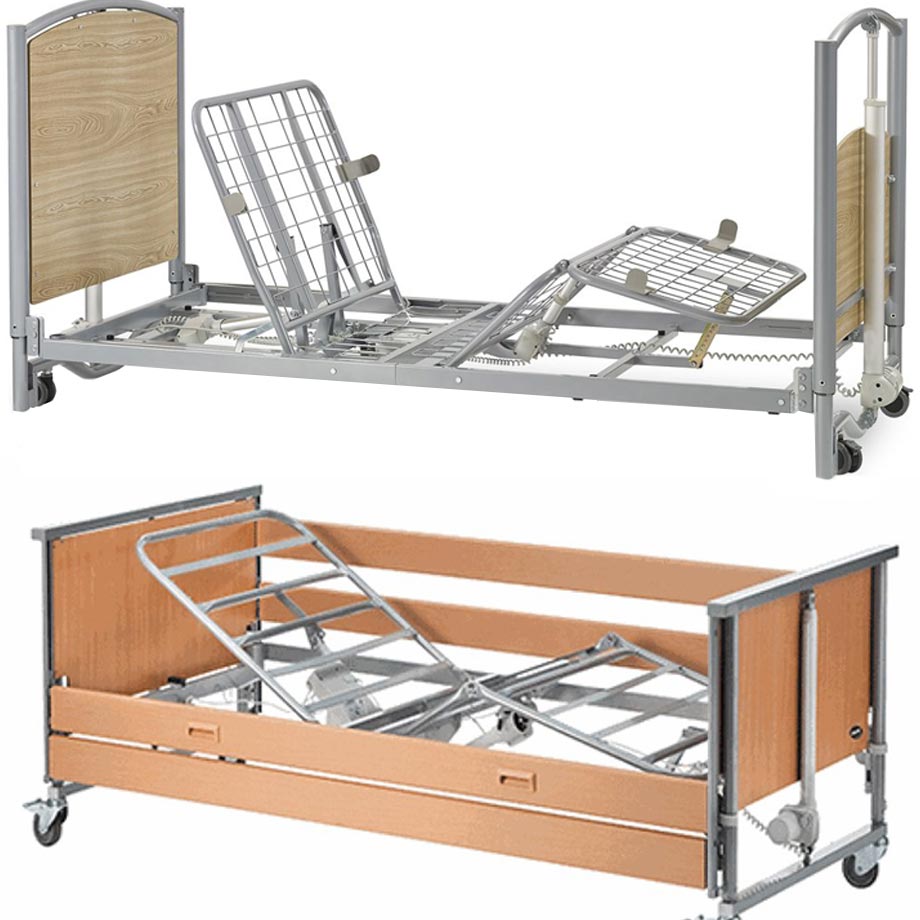

If you or the person you care for spends a lot of time in bed, then a profiling bed could be a great option as they're specially designed for those with high care needs. This means the person using the bed can rest in comfort, while making it a little easier for the carer to help them when needed.
Profiling beds can make a positive difference to people with mobility problems as well people with injuries that mean they have to spend prolonged periods of time in bed. In this guide, we will explain what profiling beds are, how they can help, the features that they offer and the different types of profiling beds that are available.
Please note that every individual's needs are different, and you should base your purchasing decisions on your particular needs and preferences and, where appropriate, upon advice from medical and/or healthcare professionals.

A profiling bed is a specialised bed that can lie flat but which has an adjustable base with multiple segments that can be raised and tilted, either together or independently of one another. Combined with a profiling mattress, a profiling bed allows for a number of different configurations, such as raising the head end to allow the user to sit up comfortably to read, watch television or talk with friends.
Other common positions include having the legs elevated relative to the body, which helps to reduce fluid build-up and raising the knees, which may be more comfortable for those who have suffered from leg injuries.
Since profiling beds can be adjusted to provide pressure relief for different parts of the body, they may also be helpful for people who may have to spend prolonged periods in bed and who may be at risk of developing pressure sores.
Profiling beds are also useful to carers since their height adjustment means that the user can be raised to a comfortable working height.

Not all profiling beds are set to the same base height. Some are low or even ultra-low to the ground, which makes them a good option for those who are at higher risk of falling out of bed, but for whom bed rails are not suitable, whether that's due to a physical or mental health condition. These low set beds mean that the person has less distance to fall in the event they do take a tumble, reducing their risk of serious injury. For additional protection, you may want to put a crash mat at the side of the bed.
A common feature amongst profiling beds is that they raise to a comfortable height for the carer to look after the person in the bed, reducing strain on the carer, so they don't have to bend over as far to do what needs to be done in that moment.

Bed side rails are rails that are either included with the profiling bed or can be added to it. They stretch across the sides of the bed to help prevent the person using the bed from falling out of it.
These side rails are usually available in two different types: wooden slats or metal bars. The wooden slats tend to look a little less clinical in appearance, but which profiling bed you have will influence which of these you may have (if any side rails at all).
Bed side rails may not be appropriate if the person being cared for has a mental health condition that would make the side rails seem too restrictive or confining, or if they are at risk of trying to climb over the side rails.

Is the person who'll be using the bed taller than average? The majority of profiling beds are long enough to accommodate someone up to 2 meters tall, but if they're taller than this you may need to get an extension for the bed. Some profiling beds have this extension capability built into the bed, so you won't need to get anything extra. However, for other beds you may need to get a separate add-on to extend the length of the bed and make it more comfortable.
Given the nature of a profiling bed, it's important to make sure it's the right length for the person using it, as otherwise they'll be extremely uncomfortable and it could result in an injury.

The slatted or mesh platform is the platform the mattress rests on. While you may have seen a profiling bed with a mesh platform, these are starting to fall more out of favour due to the difficulties in getting them clean. Slatted platforms are much easier to clean, which is important if the bed will be used by someone else afterwards.
However, if you're choosing a bed for private use being able to clean the platform so it can be used with someone else may not be a concern.
Remember: it's very important to speak to a healthcare professional before buying a profiling bed to make sure you purchase the right one for your needs.

When looking at profiling beds you may notice that some list a 'safe working load' in the specifications while others have the 'maximum user weight' or, in some cases, both. The safe working load means the maximum weight the bed can safely take.
It's important to know that the weight limit for the safe working load also includes the mattress that will be used on the bed, so if the safe working load is 28st this does not mean that the bed is therefore suitable for someone who weighs 28st. The user weight limit would be the safe working load minus the mattress weight.

Things to consider when buying a profiling bed
There are quite a few considerations that go into deciding whether or not you'll need a side rail on the profiling bed. The first is the mental health of the person using the bed - will a bed side rail make them feel imprisoned or hemmed in, causing them distress? Are they likely to try and climb over the side rail?
Secondly, are they at a risk of falling out of bed? Then a bed side rail could help to reduce this risk.
It will need to be at a suitable height for transfers, such as moving from the bed to a chair or having them at a height that will help them with standing.
You may also want to consider the height of the bed in relation to the person's fall risk - the lower the bed the less likely they'll get seriously injured if they fall. There are profiling beds available where the platform can be set almost at floor level and then raised up again as required, so the carers can tend to the person without having to strain themselves.
If they're over 2 meters tall it's highly likely that the profiling bed you need will require an extension. Check to see if the bed you're looking at has the capability to extend or if you'll need to purchase the extension separately. If in doubt, always speak to a healthcare professional for advice.
Bed grab rails can help make it easier for someone to get in and out of bed. Owing to the specialist nature of profiling beds, not all bed grab rails will be suitable for use with one, but there are some available like the NRS Community Bed Grab Handle MK2 and the Grab Rail for Profiling Beds. It's important to check that the bed grab rail is suitable for a profiling bed to avoid disappointment.
By their nature, profiling beds are designed to be as a safe as possible as they're designed for use by people with high care needs, however, there are some things to keep in mind.
Profiling beds FAQs
Profiling beds are designed to help patients with mobility issues. They have a base that can be adjusted and raised to create different angles and positions, allowing the patient to sit up or lie down in comfort. This type of bed is particularly helpful for preventing pressure sores, which can be caused by long periods of immobility.
Profiling beds offer many benefits over a standard bed, such as adjustable head and foot sections, adjustable bed height, and the ability to tilt and recline the bed for better positioning. This makes it easier for people with limited mobility to move around in bed or get into and out of bed.
They can come with side rails to provide extra safety, and some models also come with advanced features such as bedside controls, adjustable mattress firmness, and advanced pressure management. These features will help reduce the risk of skin breakdown and improve patient comfort. Finally, profiling beds can help to reduce the amount of manual handling needed to move and position patients, thus reducing the risk of injury to carers.
Low profiling beds may be better for some people, depending on their individual needs. Low profiling beds are typically shorter in height than standard beds, making it easier to get in and out of them. Additionally, low profiling beds can be beneficial for people who suffer from acid reflux or other conditions that can be exacerbated by sleeping at a higher elevation.
To use a profiling bed, you will need an appropriate mattress, one that's flexible enough to move with the bed frame while also having pressure relief properties. A standard mattress just isn't suitable for a profiling bed. Profiling mattresses offer the support and comfort for muscles and joints, designed to help spread the weight of the body more evenly and reduce the risk of developing pressure sores.
We have a wide range of profiling mattresses to suit differing needs. The type of mattress you'll need will depend on how high the person's risk of developing pressure sores is and if they need a bariatric mattress, which is a mattress designed for people of a higher weight.
Shop profiling mattresses
When you purchase a profiling bed from us you have the option of choosing kerbside delivery, which is where the bed will be delivered to your home and nothing more, or you can choose our highly recommended home assembly and delivery option. This is where our delivery and installation partners will not only deliver the bed for you, but will set it up too. It's a great option to consider as putting together a profiling bed for the first time can be quite tricky and you need to be reasonably strong to do it.
Now that you’ve read our profiling beds user guide, we hope that you understand more about what they’re for, how to choose one and how to use it once you’ve picked one.
As well as profiling beds, there are other types of bedroom aids at Complete Care Shop. You can find more information on our full range of aids – including bed rails and cot sides, mattress toppers and waterproof bedding.
If you need more help, you can contact our Occupational Therapists for further advice on the right type of bedroom aid for you.